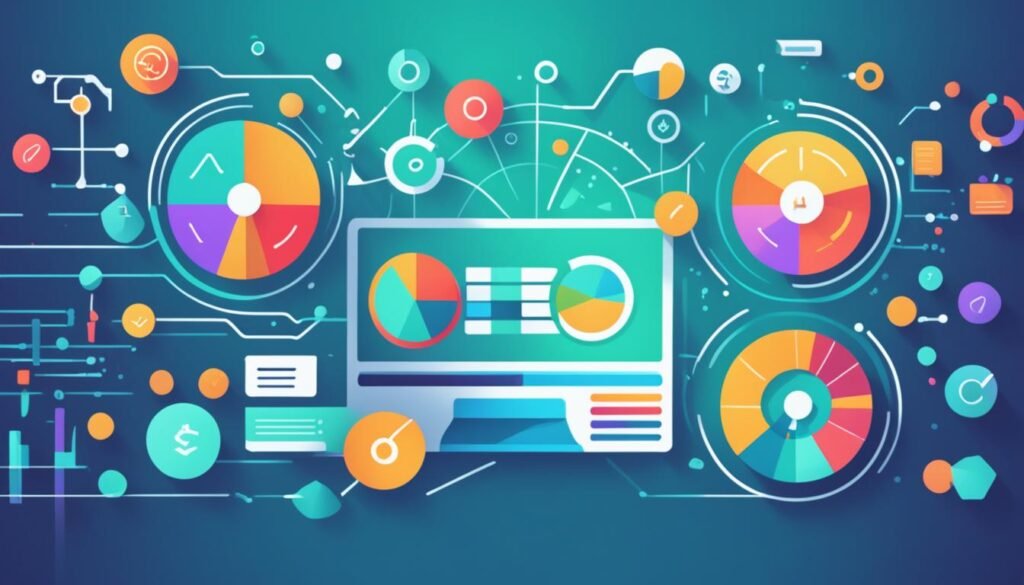Finding sales-ready leads is key to boosting your marketing and sales. Lead scoring automation helps by sorting leads based on how well they fit and engage with your business. It uses numbers to rate leads based on their data, helping you focus on the best leads.
Using lead scoring automation can make your sales process smoother. It can also increase conversion rates and help your business grow. In fact, predictive lead scoring makes companies 2.3 times more likely to hit their sales goals (Aberdeen Group). Also, teams with aligned sales and marketing see a 208% jump in marketing revenue (HubSpot).
Automating lead scoring saves time and boosts work efficiency. It also makes finding sales-ready leads more accurate. This article will cover lead scoring automation, different scoring models, and how to set up a successful strategy for your business.
Table of Contents
Understanding Lead Scoring Automation
Lead scoring automation is a smart way to give numbers to leads based on how well they fit with your business. It helps you find the best leads and focus your marketing and sales efforts. By looking at demographics, behavior, and company info, it figures out which leads are most likely to buy from you.
What is Lead Scoring Automation?
Lead scoring gives points to leads to help companies decide which ones are most important. These scores range from 0 to 100 and focus on what makes your ideal customer. You can look at things like demographics, company details, and how people interact online.
Benefits of Lead Scoring Automation
Using lead scoring automation has big benefits for your business. It lets you focus on leads that are most likely to buy, making your sales team more efficient. It also helps you use your resources better, increase sales, make marketing more personal, and speed up the sales process.
By making marketing and sales work together, lead scoring automation makes managing your sales pipeline easier. This leads to better business growth.

“99 out of 100 companies use the BANT (Budget, Authority, Need, Timeline) acronym for lead scoring.”
Advanced lead scoring looks at lots of data to figure out how good a lead is. It uses both direct info like job title and indirect info like website visits. Scores range from A to D for fit and 1 to 4 for how engaged the lead is.
Good lead scoring is simple, updated regularly, and involves sales and marketing teams. This ensures everyone is on the same page and it works well.
Lead Scoring Models
Lead scoring is key to a successful B2B marketing plan. It gives points to leads based on their data and actions. This way, you can spot the best leads for your sales team. By focusing on these leads, you boost your marketing and sales results.
Demographic Scoring
Demographic scoring looks at a lead’s job title, company size, and more. It aims to see if a lead matches your ideal customer profile. This helps you find leads that are likely to buy from you.
Behavioral Scoring
Behavioral scoring checks how leads interact with your company. This includes website visits and email opens. The more they engage, the higher their score, showing they’re ready to buy.
Firmographic Scoring
Firmographic scoring looks at company details like industry and size. It helps you focus on companies that fit your products well. This way, you can better target your marketing efforts.

This image from freepik
| Lead Scoring Model | Key Factors | Objective |
|---|---|---|
| Demographic Scoring | Job title, company size, industry, location | Identify leads that fit your ideal customer profile |
| Behavioral Scoring | Website visits, email engagement, content downloads, webinar attendance | Determine leads’ level of interest and sales readiness |
| Firmographic Scoring | Industry, company size, revenue, location | Prioritize leads from companies that align with your target market |
“Lead scoring can be a game-changer for B2B companies, helping them focus their marketing and sales efforts on the most qualified and engaged leads.”
Lead Scoring Automation Implementation
Setting up lead scoring automation is key to finding your most valuable prospects. It helps align your sales and marketing efforts. At the core, you need to define your ideal customer profile (ICP). This means knowing who your best customers are by looking at their demographics, firmographics, and behavior.
This helps tailor your lead scoring criteria to your business goals. You’ll focus on the most valuable leads this way.
Defining Your Ideal Customer Profile
Creating a solid ICP means understanding your target audience well. Look at your current customer data to find patterns and trends. Use buyer personas to learn about their needs, pain points, and how they buy things. This detailed profile is key for your lead scoring model, making sure you focus on the right leads for your sales team.
Aligning Sales and Marketing Teams
Good lead scoring needs teamwork between sales and marketing. They must work together to define the ICP and agree on lead scoring criteria. This ensures a unified way of qualifying leads. Keeping sales and marketing in sync is key for your lead scoring automation to work well.
Leveraging Technology for Automation
Automating lead scoring makes things more efficient and accurate. Use lead scoring software with your customer relationship management (CRM) system. This way, you can handle data, scoring, and prioritizing leads better. Technology helps save time, improve personalization, and gives insights for your sales and marketing plans.

Investing in lead scoring automation changes how you qualify and nurture leads. By defining your ICP, aligning teams, and using technology, you create a feedback loop. This loop helps you grow sustainably and boosts your return on investment.
Lead Scoring Automation for Effective Lead Nurturing
Lead scoring automation is key to finding sales-ready leads and nurturing them well. It helps you understand where leads are in the buying journey. This lets you send the right messages and offers at the right time. This approach boosts conversion rates.
Understanding Lead Lifecycle Stages
Leads go through different stages before becoming loyal customers. Automation tracks and responds to leads at each stage. This ensures they get the right content and offers, guiding them towards buying.
Implementing Lead Nurturing Best Practices
Good lead nurturing is vital for lead scoring automation to work well. It means segmenting leads, sending them personalized content, and keeping in touch across many channels. This approach builds strong relationships, raises conversion rates, and grows customer loyalty.
Automation tools track how leads interact with your brand. This info helps tailor content and target leads better. CRM systems with marketing automation give a full view of leads and customers. They use data from sales and marketing to improve nurturing.
“Nurturing leads results in a 20% increase in sales opportunities compared to leads that aren’t nurtured (DemandGen report).”
Marketing automation makes campaigns run smoother by automating tasks like nurturing leads, sending emails, and managing social media. Effective automation means sending personalized content to the right groups. It also analyzes customer behavior to make nurturing better.

Automation sends emails at the best time, boosting engagement and conversion chances. By using lead scoring and best nurturing practices, you guide prospects through the customer journey. This leads to better conversion rates and loyal customers.
Conclusion
Lead scoring automation is a key tool for finding and focusing on sales-ready leads. It makes your sales process smoother and boosts your marketing and sales work. By using a smart lead scoring model, working together with your sales and marketing teams, and using technology for automation, you can sort your leads well. This helps you focus on the best opportunities and grow your business sustainably.
The Pareto Principle says that 20% of your leads will generate 80% of your revenue. A good lead scoring strategy can change how you work in marketing and sales, saving time and money. Also, 80% of what happens in your business comes from 20% of the causes. This shows how important it is to find and focus on your most valuable leads.
Keeping your lead scoring strategy up to date and focusing on nurturing leads is crucial for long-term success. By testing and checking your lead scoring often, and linking your CRM and marketing automation tools, you can stay ahead. This improves sales and marketing teamwork and helps you get the most from your investment.




One Comment on “Using Lead Scoring Automation to Identify Sales-Ready Leads 2024”